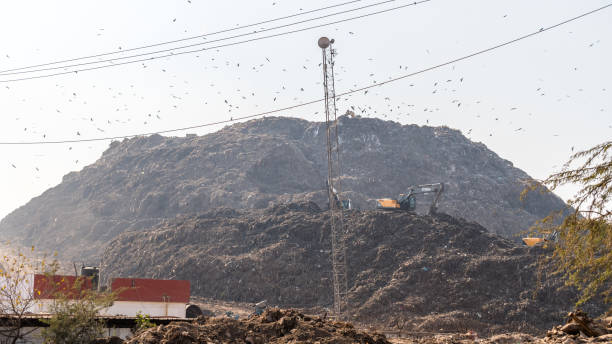With the ever-accelerating pace of urban life, how to achieve a balance between garbage disposal and environmental protection has become an issue that cannot be avoided in urban sustainable development. As one of the main ways to deal with urban solid waste, the methane gas released during the operation of landfills is not only an important driver of global warming, but also one of the important factors in the deterioration of regional air quality. Therefore, building a monitoring system based on multi-source collaboration has become a key means to improve the risk perception ability and air governance level of landfills.
The Concealment And Diffusion Characteristics Of Methane Emissions
Methane gas is colorless, odorless, and has no irritating odor. It is difficult to detect by the naked eye or smell when it leaks. However, it not only has a strong greenhouse effect, but is also flammable at certain concentrations, and has the risk of causing fire or explosion.
From the perspective of air pollution, the release of methane will participate in the formation of secondary pollutants such as ozone, which will in turn affect the local atmospheric composition and form a “gas pollution island” effect. Especially under meteorological conditions with low wind speed and stable air pressure, it is easy to form local accumulation, posing a dual threat to the health and environment of surrounding communities and ecosystems.
Therefore, it is far from enough to rely solely on traditional manual point monitoring. It is necessary to introduce multi-source monitoring methods with wide coverage, fast response speed and strong data integration capabilities to achieve real-time control and precise positioning of methane emissions.
Technical Path And Advantages Of Multi-Source Collaboration
Building an efficient landfill air quality monitoring system usually includes the collaborative work of three types of key equipment:
Ground fixed detection equipment: often located at the boundary of the landfill area or in areas prone to leakage, and can sample methane concentration 24 hours a day. Advanced detectors can achieve ppm-level detection accuracy through the infrared absorption principle (NDIR), and can operate stably in environments with large temperature and humidity fluctuations, adapting to long-term monitoring needs after the site is closed.
Mobile detection platform: drones or vehicles equipped with methane detectors can quickly inspect large areas of landfills. Especially in the case of sudden changes in wind direction or high temperature weather, the methane concentration may change drastically. Such mobile platforms can achieve high-frequency scanning and hot spot capture, which is a powerful supplement to traditional monitoring.
Data integration and analysis platform: After the data collected by multi-source equipment is uploaded to the platform, the system can analyze it according to the time and space dimensions, identify the concentration fluctuation trend, spatial distribution characteristics and leakage possibility, and combine meteorological data and historical data for predictive modeling to assist management in formulating scientific response strategies.
This multi-source collaborative framework not only improves the response speed and perception ability of landfills to methane emissions, but also greatly reduces labor costs and the risk of missed detection, providing more powerful data support for regulatory agencies.
The Adaptability And Technical Advantages Of The Detector
The role of high-performance methane detectors in multi-source collaborative systems is irreplaceable. Its miniaturized design and low power consumption characteristics enable it to be deployed as a fixed device for a long time, or installed on mobile platforms such as drones and remote control cars. Some detectors are equipped with infrared thermal imaging and laser ranging modules, and have high environmental adaptability. They can operate stably in extreme environments with high humidity, strong winds, and dust.
In addition, they have remote control and data synchronization capabilities, and can transmit monitoring results in real time through wireless networks to form a complete concentration time series diagram and regional concentration heat map, which is convenient for quickly locking abnormal sources and optimizing maintenance and risk prevention and control processes.
Some models also support edge computing functions, which can directly perform data preprocessing and abnormality identification on the device side, greatly reducing the data processing pressure on the platform side and improving the response speed of the entire system.
Application Practice: Building a “Smart Fence” To Achieve Dynamic Early Warning
Take a large domestic landfill as an example. The area where it is located has a high population density and strict environmental protection standards, and attaches great importance to gas emission supervision. The landfill has deployed a methane monitoring system based on the concept of “smart fence”, and deployed several high-precision detectors around the landfill area. Combined with regular drone patrols and meteorological tower data input, three-dimensional monitoring and dynamic early warning are achieved.
Whenever the detector detects that the methane concentration is close to the safety threshold, the system will automatically trigger the early warning mechanism, prompting the operator to start emergency response measures such as regional ventilation and sealing inspection. The intelligent platform can also analyze high-risk time periods and emission peaks based on historical data, and adjust the landfill operation process, such as adjusting the frequency of covering soil, compaction degree and opening time of the gas well, so as to effectively reduce the possibility of high-concentration methane.
According to on-site operation data, the fluctuation range of methane emissions in the landfill has dropped significantly since the system was launched, and the number of complaints from residents has decreased by about 70%, becoming a new example of intelligent environmental protection supervision.
Conclusion: Technology Empowers And Reshapes The Landfill Air Governance Model
Faced with increasingly complex urban solid waste management needs, a single monitoring method can no longer meet high standards and refined environmental protection goals. The multi-source collaborative methane monitoring system realizes the dynamic perception of “point-line-surface” integration by integrating high-sensitivity detectors, flexible deployment platforms and intelligent analysis systems, greatly improving the environmental governance level of landfills.
More importantly, with the help of these technical means, not only can safety accidents be prevented and air quality protected, but also a solid foundation for building a more sustainable urban waste management system has been laid. Under the general trend of green transformation and low-carbon development, scientific methane monitoring capabilities have become an important indicator for assessing the level of urban ecological civilization construction, and have also provided forward-looking decision-making basis for urban managers.



